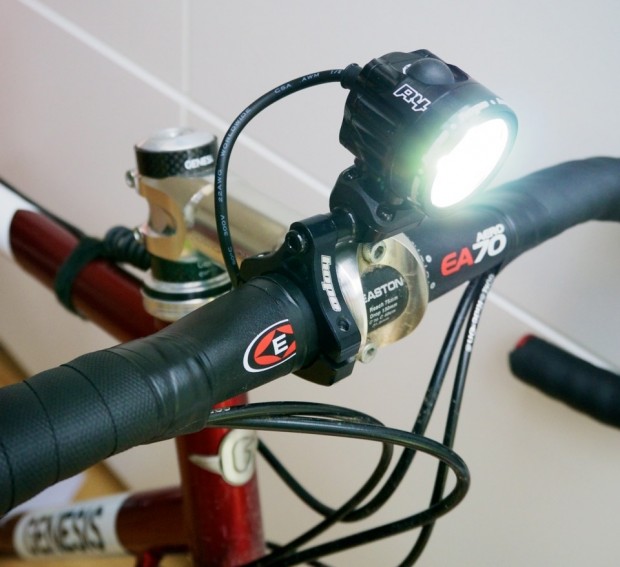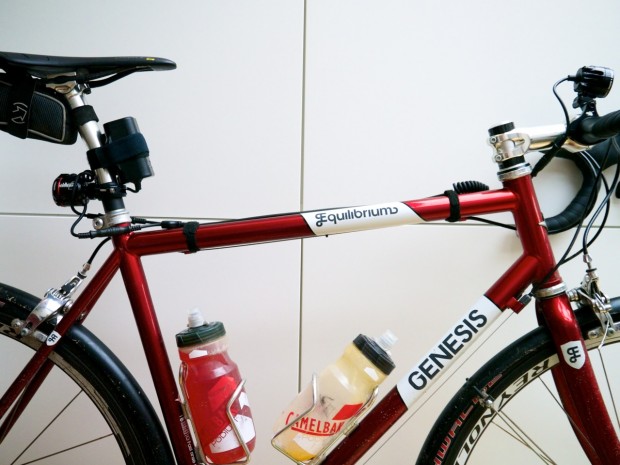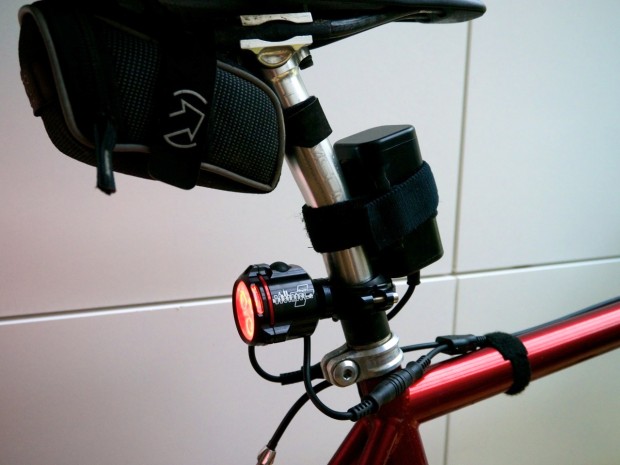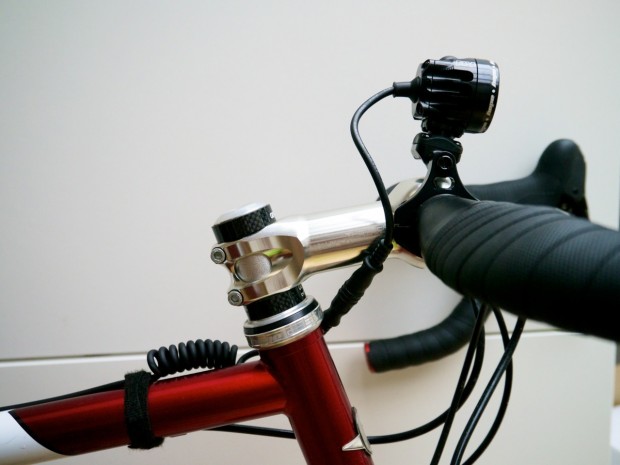A full month of night riding with the Hope R4 headlight and District rear light has been illuminating to say the least. This is a seriously bright lighting set up.
We considered the general costs and modes in our ‘first look’, so let’s get straight down to business and focus on the performance.
We’ll start with the R4 front light, one revised for model year 2013.

I was impressed with the clamp, which is a slim, machined design, able to sit close to the stem, and which allows the light to be placed above the clamp, in the centre of the cockpit.
A further neat design touch is the bayonet-style system with which the light is secured. A spring-loaded button on the underside of the light and machined grooves in the clamp allows the light to be firmly attached to the bars with a simple push-and-twist action. It is equally easy to remove: a handy feature if using the light for commuting or even for washing the bike at the end of a ride.
As we anticipated during our ‘first look’, we spent most time in the Race mode (as opposed to the Trail mode), and used the 630-lumen setting for the majority of our riding time.
Hope have resisted the trend for an integrated battery and lamp unit with the R4. Instead, two separate battery units are supplied. While we’re not unduly concerned by weight at this time of year, the sheer size of the larger battery meant that nearly two-thirds of our testing was completed with the half-sized unit, which still provided two hours of burn time at the highest 630-lumen setting: easily enough for a good evening winter road ride after work.
If you want a longer foray, your best bet is to suck it up and carry the larger battery. In the view of this tester, it is not worth dropping below 500 lumens when riding unlit country lanes at night.
The smaller battery mounted neatly beneath the saddle and above my saddle bag, which also endeared it to me. The larger pack had to be frame-mounted, offending my inner aesthete; for longer jaunts, needs must.

The most important part of the equation, however, is real-world battery life and here we were impressed. Burn times either matched or exceeded by a small amount those quoted by Hope.
The lack of a battery indicator was a source of concern for some riders with whom we discussed the light, but the general consensus was that most people know how long they have used a light and place it on charge as soon as they return from a ride.
Some may argue that such practice represents bad form for battery life, but we have yet to experience any problems with the Li-Ion unit; common sense surely prevails, and if there is a cost saving by not including a fuel gauge, then we are happy to take it.
The four Cree XPG LEDs which provide the light source in the tidily machined head unit are punchy. Its broad beam is cast in a soft diamond shape. We hit speeds up to 25mph, secure in the knowledge that the beam would highlight obstacles a sufficient distance ahead, even at that speed.
Angling the beam correctly is something of an art in our view – possibly due to our induction many years ago into off-road riding at night when early systems did not push out the brightness of contemporary units. A balance had always to be struck between slow speed, twisty technical singletrack illumination, and high speed fire road blasting.
The same balancing act is required with the vastly superior Hope R4, but for a different reason. We were concerned that its broad beam could upset traffic, and so focussed it downwards, on to the road, and not off into the far distance, where drivers may have felt dazzled. This may have been an unnecessary precaution (remember, of course, that the oblique angle of oncoming traffic is outside the brightest part of the beam spread, and so should not be too disrupting to drivers) but one we’d recommend.

At the rear, the District makes for a great night time companion. It employs a similar bayonet-style clamp mechanism to the R4 headlight, although this time enclosed in a specially adaptable seatpost collar, giving the rear light the same simplicity of attachment and removal, and the same firmness.
Much discussion was had on my first group night ride with the District regarding the efficacy of light; certainly it increased visibility, but was it at the risk of upsetting following traffic or riders?
Hope have combatted this potential problem by supplying the District with a clever, curved collar clamp, which allows you to angle the District down a little to avoid angling the beam directly into the eyes of following traffic, four-wheeled or otherwise.
Clearly, the flashing settings are meant to create a visual disturbance, and you would never use them in a pack of cyclists, but the sheer brightness of the District meant there was no need to use them in traffic either.
A quick survey at a set of traffic lights (two cabbies and one bus driver), revealed that all of them preferred the constant settings to flashing (they claimed that while the flashing settings were noticeable, they were also distracting). Okay, it’s certainly not a scientific test, but I thought the result was worth thinking about.
In a pack, the low power constant setting was fine for all riders in the group and meant that nobody was dazzled. On solo rides out into the wilds, I chucked the light on full power constant beam as the rear light does everything I feel I need out of a light…make me more visible to following traffic.

Burn times from the 2.6Ah battery (the smaller unit) are good: a month’s worth of commuting on the low power constant setting (40 hours), and on the high constant mode you can ride for a week (10 hours), or at least that was how it worked out for me. The flashing modes sit between at 20 hours, and the strobe mode (tough on the retinas) will keep going for over 50 hours. Yikes!
So we liked the front and the rear lights: good clamps, great illumination, very well made, a little pricey, but not excessive. So what are the drawbacks? In our view, there was only one, and then only because we like our bikes tidy.
There are, with the ‘one battery-two lights’ system, a lot of unsightly cables. It’s not that bad, and we like the idea, but we could never find a brilliant place for the large battery pack, and while Hope have done a neat job of providing some handy velcro straps and a coiled cable, we still didn’t like the clutter along our top tube.
With such a neat attachment system and robust clamps, it would be nice to see Hope start to integrate batteries into their beautifully machined units; then I think they would have some real winners, especially with the District+ rear light.
Price: Hope R4 – £250
Price: District – £160 (with two-cell battery, charger, and splitter cable) OR £95 (without battery, but with splitter cable to be powered from R4)
Website: Hope Technology
UK distributor: Hope Technology




